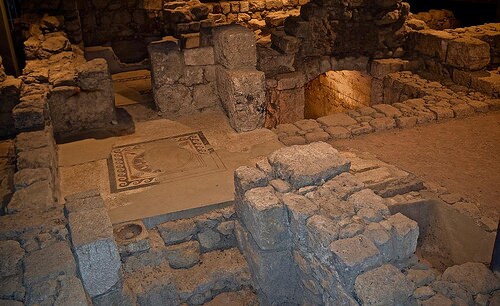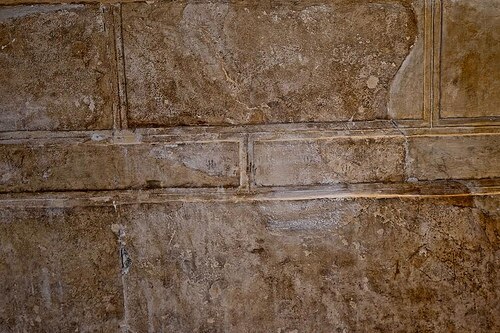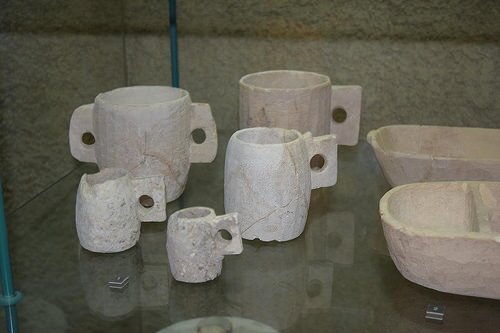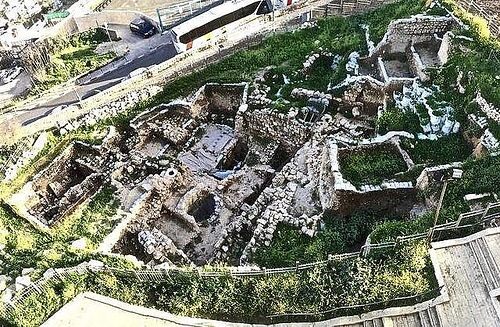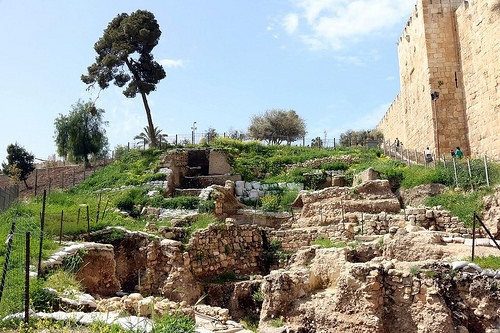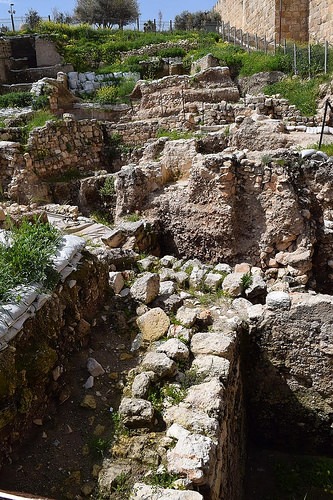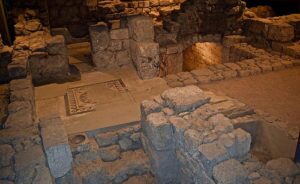
Standing in a public square in Jerusalem’s Jewish Quarter, it is not unusual to see groups of tourists filing into the shops and restaurants that line its periphery. Many of them have just seen some of the nearby iconic sites, only steps away, that until now they have only glimpsed in photographs or read about in books and magazines — the Western Wall; the sacred area known as the Temple Mount (to Jews and Christians), otherwise known as the Haram esh-Sharif (to Muslims); the Tower of David; the Cenacle – the ‘Upper Room’ for Christians; and the Tomb of King David. These are sites that have drawn pilgrims and visitors alike for centuries.
Some of these tourists may not know, however, that just 3 meters beneath their feet are the remains of another, hidden ancient Jerusalem that doesn’t easily meet the visitor’s eye, yet nonetheless would surely astound any beholder as much as the better known iconic shrines. Tucked away beneath the modern-day pavement, they are the remains of the most affluential neighborhood of 1st century Jerusalem’s Jewish power elite.
Today it is known as the Herodian Quarter. To date, archaeologists have excavated only a segment of this ancient upscale community — the remains of six homes sporting, what for Jerusalem society was the latest and best in materials, style, and interior decorative splendor, adapted to conform with the requirements of Jewish religious laws of the time. Elevated and spread across the western hill, they overlooked what at that time was the Herodian re-built Second Temple and its Mount, one of the architectural wonders of the 1st century CE Roman world.
It must have been a wonderful view.
The Excavations
As the historical record and archaeological excavations have attested, these finely appointed mansion-like homes were destroyed and burned shortly after the destruction of the Second Temple by the Romans following the First Jewish Revolt. Succeeding centuries saw construction of new structures atop their ruins, so that by the time a team under the renowned Israeli archaeologist Nachman Avigad began digging in the 1970’s, only the basements remained to be revealed. Even so, they were two stories in depth, and over time the team had uncovered the remains of storage rooms, frescoed walls, remarkably well-preserved floor mosaics, mikveh or ritual baths, decorated tables, fine imported ceramic ware, stone vessels (used to comport with Jewish ritual purity laws), water cisterns, kitchen ovens, and a host of other artifacts. Analysis of the remains indicated that the homes were at least two stories high, not including the basements. The basements were used as storerooms, washrooms and ritual cleansing. The upper floors featured kitchens and bedrooms.
Who lived in these privileged accommodations?
Historians and archaeologists suggest they were likely the homes of Jerusalem’s priestly class. This would include the officiating priests of the Temple and members of the Sanhedrin. They were individuals like the High Priest Caiaphas, the man who, according to the New Testament gospel accounts, organized the plot to kill Jesus; and the High Priest Annas, Caiaphas’ powerful father-in-law. The proximity of the homes to the Temple Mount, the opulent nature of the structures, the interior features and decorative elements, the artifacts recovered, and the dating of the finds—all have provided strong evidence that this would have been a slice of their residential community.
Now, new excavations very near and just south of the Herodian Quarter excavations on Mount Zion continue to support this suggestion. Under Shimon Gibson and co-director James Tabor of the University of North Carolina, Charlotte, archaeologists have recently uncovered what they interpret to be more of the likely residential area of wealthy families of the priestly class, dated to the same time period as the Herodian Quarter excavation only a stone’s throw away to the north. They know this from the numerous tell-tale finds, particularly the remains of the basement of an upscale house, which included a stepped, plastered ritual bathing pool or mikveh, a bathing room with a ‘bathtub’-like feature very similar to one found in the Herodian Quarter excavation, bread ovens, a plastered cistern, a well-preserved vaulted ceiling, and associated artifacts. One particular artifact stood out among the small finds and helped to cement the suggestion of a priestly residence: “Among the special finds from the 2009 season of excavations was a soft white limestone cup dating from the first century C.E. bearing an incised inscription, with ten or perhaps eleven lines of script on its sides,” wrote Gibson.** The cup was found in four pieces within a fill layer containing 1st century pottery fragments above a barrel-vaulted ceiling of a mikveh. It represented a well-known type of 1st century cup found in excavations throughout Jerusalem and beyond. Study of the cup and the historical context of its finding suggests that it might have been a ritual cleansing cup, used for the washing of hands before engaging in liturgical functions. Suggests Gibson, “the discovery of the cup in the area of the Upper City of Jerusalem, in which priestly families are known to have resided (including the Qatros family*), may hint at the original priestly function that this specific vessel had some two thousand years ago.”** Also of note was the discovery of a gold coin bearing the image of the Roman Emperor Nero, struck in 56/57 AD. “It’s a valuable piece of personal property and wouldn’t have been cast away like rubbish or casually dropped,” says Gibson. “It’s conceivable that it ended up outside these structures in the chaos [the Roman destruction of Jerusalem in 70 AD] that happened as this area was destroyed.” The find is additionally rare because it is the first time such a coin has been excavated in a controlled archaeological dig.
Excavations at the Mount Zion location are ongoing, and archaeologists are confident that much more will be unearthed that will help further define the lifestyles of the rich and famous of Jerusalem at a pivotal time in the history of the region.
_________________________________________
Above and below: Finely built structures, including floor mosaics, wall frescoes and mikvehs, characterized even the basement levels of these homes (see images below). Depicted above is a triclinium and courtyard of a palatial mansion home.
____________________________________________
Above: Example of decorative wall detail.
______________________________________________________
Above: Stone vessels recovered from the Herodian Quarter excavations. Courtesy Victoria Brogdon
___________________________________________
Above: Aerial overview photograph of the Mount Zion excavations. Courtesy Victoria Brogdon
_____________________________________________
Above and below: The Mount Zion excavations are just south and adjacent to the south wall of the Old City of Jerusalem, not far from the Herodian Quarter, which is inside the wall. The wall of the city during the 1st century CE was further south from this point, such that the remains found in the Mount Zion dig and those of the Herodian Quarter would have both been within or behind the city wall. Photos courtesy Victoria Brogdon
______________________________________
Above and below: Detailed views of the Mount Zion excavations.
__________________________________________
Readers can learn more about the Herodian Quarter, otherwise known as the Wohl Archaeological Museum, here and here, and more about the Mount Zion excavations at this site.
__________________________________________
*https://www.researchgate.net/publication/283255501_Bar_Qatros_and_the_Priestly_Families_of_Jerusalem
**Gibson, Shimon, Preliminary Report: New Excavations on Mount Zion in Jerusalem and an Inscribed Stone Cup/Mug from the Second Temple Period, University of North Carolina at Charlotte and University of the Holy Land, Jerusalem, 2010
_________________________________

______________________________________________
Travel and learn with Far Horizons.
____________________________________________
This richly illustrated issue includes the following stories: Recent findings shedding new light on the whereabouts of the remains of Philip of Macedon, father of Alexander the Great; how an archaeologist-sculptor is bringing bones of the dead back to life; archaeologists uncovering town life at the dawn of civilization; an exclusive interview with internationally acclaimed archaeologist James M. Adovasio about what makes the Meadowcroft Rockshelter prominent in the ongoing search for the first Americans; what archaeologists are finding at the site of the ancient city of Gath, the home town of the biblical Philistine giant, Goliath; and how scientists are redrawing the picture of human evolution in Europe. Find it on Amazon.com.


